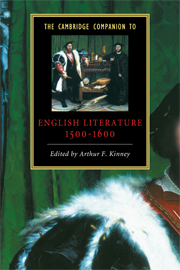Book contents
- Frontmatter
- 1 Introduction
- 2 The sixteenth century
- 3 Tudor aesthetics
- 4 Authorship and the material conditions of writing
- 5 Poetry, patronage, and the court
- 6 Religious writing
- 7 Dramatic experiments
- 8 Dramatic achievements
- 9 Lyric forms
- 10 Narrative, romance, and epic
- 11 The evolution of Tudor satire
- 12 Chronicles of private life
- 13 Popular culture in print
- 14 Rewriting the world, rewriting the body
- 15 Writing empire and nation
- Index
1 - Introduction
Published online by Cambridge University Press: 28 May 2006
- Frontmatter
- 1 Introduction
- 2 The sixteenth century
- 3 Tudor aesthetics
- 4 Authorship and the material conditions of writing
- 5 Poetry, patronage, and the court
- 6 Religious writing
- 7 Dramatic experiments
- 8 Dramatic achievements
- 9 Lyric forms
- 10 Narrative, romance, and epic
- 11 The evolution of Tudor satire
- 12 Chronicles of private life
- 13 Popular culture in print
- 14 Rewriting the world, rewriting the body
- 15 Writing empire and nation
- Index
Summary
A currently recognized representation of the Tudor aesthetic in the sixteenth century is Hans Holbein's double portrait of “The Ambassadors” painted in the spring of 1533 in London (Figure 1), yet its significance and its actual meaning have been debated. For Stephen Greenblatt, the painting represents a cultural poetic that is essentially humanistic. The work is seen from the perspective of the courtly and social and it emphasizes the vast and varied knowledge humanism had come to represent at the Henrician court: 'Jean de Dinteville, seigneur de Polisy and Francis Fs ambassador to the English court, and his friend Georges de Selve, shortly to be bishop of Lavaur, stand at either side of a two-shelved table. They are young, successful men, whose impressively wide-ranging interests and accomplishments are elegantly recorded by the objects scattered with careful casualness on the table: celestial and terrestrial globes, sundials, quadrants and other instruments of astronomy and geometry, a lute, a case of flutes, a German book of arithmetic, kept open by a square, and an open German hymn book, on whose pages may be seen part of Luther's translation of the “Veni Creator Spiritus” and his “Shortened Version of the Ten Commandments” ...'
- Type
- Chapter
- Information
- Publisher: Cambridge University PressPrint publication year: 1999
- 1
- Cited by



